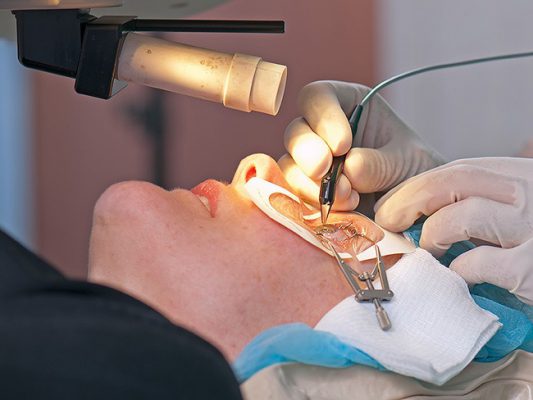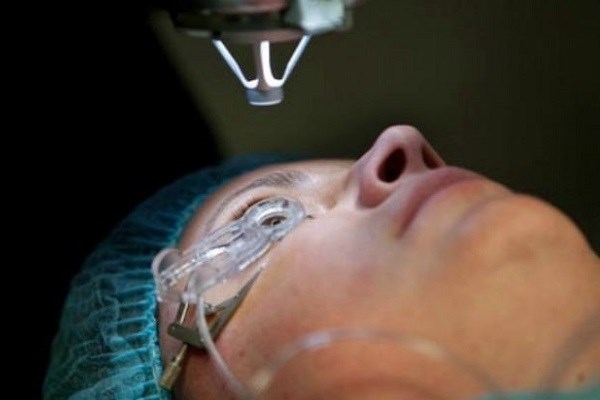LASIK and LASEK Procedure in Iran
The use of LASIK and LASEK is to reduce or eliminate hyperopia, myopia, astigmatism, and to get rid of eyeglasses, except that LASIK cannot be performed in patients with extreme myopia.
In LASIK surgery, a layer of the cornea is gets cut and removed, and after being shaved, the layer is restored, but in LASEK and PRK, the most superficial corneal layer is trimmed and treated without ejection, resulting in complications. The corneal thickness of the patient is an important factor in the ophthalmologist prescribe LASEK for the patient. If the patient’s cornea is too thin, the LASEK is usually suggested instead of laser. Patients jobs also have an influence on this choice, for example, patients such as boxers, who usually get hit in the eye, are not good candidates for LASIK surgery and LASEK is better for them.
The Food and Drug Administration (FDA) has approved the excimer laser for correction of myopia (up to -12 diopters with -4 diopters of astigmatism), and hyperopia (from +1 to +6 with 1 diopters of astigmatism). Negative diopter means myopia and positive diopter means hyperopia.
Almost everyone who undergoes surgery wants to know what are the chances of getting a satisfying result. For low to moderate myopia (up to -7 diopters), about 95% of patients received 5.10 to 6.10 or more vision without glasses, and 85% had a chance of from 8.10 to 9.10 or more vision without eyeglasses. This means that people’s dependence on glasses is greatly reduced, but they may need a smaller number of glasses to perform more precise eye tasks, such as driving, especially at night.
For high myopia (above -7 diopter), about 85% of patients get 5.10 to 6.10 or more vision without glasses and 70% get glasses 8.10 to 9.10 or more vision without glasses.
The Food and Drug Administration (FDA), in collaboration with the American Society of Ophthalmologists, considers the following to be appropriate for LASIK:
You must be at least 18 years old (for some lasers 21), because the vision of people under 18 usually changes.
For elderly patients with eye disease, LASIK is not a refractive problem correction because one eye sees both distances, close and near.
Femtolasik
This surgery is somehow new and is a type of LASIK that is performed with a femtosecond laser. The layer removed by femtosecond is thin and it is possible to remove a layer with 90 μm thickness from the cornea and the possible complication of femtolasik is less than LASIK, but the possibility of keratoconus in thin corneals is higher than LASEK.
In the first stage, a thin layer of the corneal surface is removed, and in the second stage, laser radiation is applied to the cornea.
Zyoptic and Tissue Saving procedures and their relationship with PRK, LASIK and etc.
These techniques are for the second stage. In the first stage, we use PRK, LASIK, or femtolasic techniques and prepare the patient’s cornea for laser operation. At the laser stage, we also have special features such as zyoptic and Tissue Saving to optimize the cornea as best as possible and optimize vision and eyesight number correction.
»Ophthalmologists always recommend using glasses
But there are still some people who don’t like glasses and prefer to live without glasses. There are two ways to do this, one is using contact lenses and the other is LASIK. The lens was introduced to the market nearly 90 years ago and is now easily accessible and used, and many people use them to live without glasses and for beauty purposes.
If not used properly, the lens increases the likelihood of corneal ulcers and eye’s sensitivity, which is why specialists were looking for another alternative and they studied on surgical procedures.
The risk of LASIK is much lower than using contact lenses because it always puts the eye at risk, but in LASIK the risk is only during and a few days after surgery. However, it should be noted that LASIK also has its own conditions, for example, one’s eyesight number must be fixed and it is used according to one’s needs.
The cost of LASIK in Iran is very low compared to all countries in the world, even Bangladesh. Whereas the machines in Iran are also technologically superior to European countries.
Laser Surgery Criteria
The LASIK and Laser (LASEK and PRK) criteria are:
»Minimum age of 18 years and up to maximum until one has cataract.
»No significant change in the eyesight number in the past year, ie more than 0.5 diopters.
Sufficient corneal thickness
Myopia -2 to -10 diopters
Astigmatism 0.5-6 diopters
»Up to +6 diopters hyperopia
»Absence of keratoconus or irregularities in the corneal surface
»Lack of general illnesses such as rheumatism, advanced diabetes and immunodeficiency
»One shouldn’t be pregnant or breast feed
»Absence of eye diseases such as glaucoma, cataract, moderate to severe dry eye and herpes simplex in the eye.
»Pupil’s not too wide in the dark
Having realistic expectations of laser (PRK or LASIK) abilities in vision correction.
If you use soft contact lenses, stop using your lens at least a week before the procedure.
If you use rigid gas-permeable contact lenses, stop using your lens at least 3 to 4 weeks before the procedure.
If we suspect that the corneal changes caused by the contact lens have not returned to normal after removal of the contact lens, the refractive problem measurement is repeated at intervals of one to several weeks until the refractive problem is stable, and then preoperative tests are performed.
Complete ophthalmologic examination including slit lamp examination, eye strain measurement, eye movements and posterior examination of the nerve and retina (after applying pupil dilation drop) and accurate refractive problem (eyesight number) and the measurement of vision is done.
Specific color photographs, called topography and purity metrics or orb scans, are used to evaluate the cornea in terms of measuring corneal thickness and making sure of absence of keratoconus and irregular astigmatism and examining the details of the optic map of the corneal surface. After gathering necessary information about capabilities and limitations of the procedure you can decide, having realistic expectations.

Preoperative care
Bathe the day before the operation and rinse the eyelid edges thoroughly with diluted baby shampoo. Do not use perfume, cologne and other fragrances on the day of operation (laser device is sensitive to odor) and avoid putting make up on eyelid edges.
Surgery is outpatient and takes 10 to 15 minutes for each eye.
Most patients who are waiting for surgery may become anxious about the procedure and worry about the outcome of their operation. Most of the times this anxiety is accompanied by a degree of eagerness and expectation. Know that your trusted physician has sufficient experience and they will do their best to achieve the best results so don’t worry so you can follow the surgeon’s instructions well, especially during the surgery.
Anesthesia drops are applied before the procedure begins. You will not have much pain during the procedure. The eyelids are disinfected with iodine solution. Then you lie on the bed in the laser room, and an anesthetic drop is applied into your eye once again. Your eyelids will be held open by a special device and the operating room microscope is placed in front of your face. Inside the microscope there is a small red light that is stable at first and then flashes during laser procedure. To increase the accuracy of the correction, you need to stare at this light regularly (especially when you hear the laser sound).
Postoperative risks:
Excessive or less than usual treatment may occur, which may require another surgery, contact lenses, or glasses. The following is a list of many that will be resolved over time.
• Glare
• Halos or starburst at night
• Corneal infection: fortunately, complications such as corneal infection are very rare.
• Some patients might have better eyesight after the surgery but still need eyeglasses for good vision.
• Disturbances may reduce the accuracy of the distinction, and even with a 10/10 view the objects may look blurry or brown.
• Light sensitivity.
• Dryness.
• Scratches.
• Myopia at night: Because in this operation only the central part of the cornea is deformed, at night when the pupil is opened light enters from around the cornea, which has not been deformed, causing myopia. Even if there is excellent daytime vision, at night it may be necessary to have a glasses for better vision.
But the most important side effects of LASIK are those that can reduce the vision of one or two eyes and will not be corrected by glasses. The causes of vision loss in these patients are mainly irregularities in cornea or corneal opacity. One of the most common causes of irregularities in cornea is keratoconus which is more common in LASIK and femtolytic than LASRK and PRK. But corneal opacity is caused by post-surgery inflammation or infection. Fortunately, the above complications are very rare and can be prevented by up to 90%. However, if they do occur, they may be a little difficult to treat, and will require further treatment and actions. Although many of these complications can be reduced by preventative actions, they can rarely occur. In one study that we had on a large number of patients, the chance of vision decrease was about one in a thousand. According to these statistics, it can be concluded that LASIK is more reliable than other surgeries.
Postoperative care
After your LASEK operation, your eyes will experience pain and sensation for up to two to three days, and especially on the first night, you may have severe pain that require more pain killers, but don’t worry, resting in an almost dark room and using ice compresses and cold towels will help.
In the first few days after surgery, don’t rub your eye. To drop the eye drops, just pull the lower eyelid down and apply the drop into the eye. Never touch your upper eyelid.
Try not to have pressure on your eyes in the first week after surgery. Visual changes (your vision is sometimes blurry and sometimes clear), a slight burning sensation and sometimes a headache is normal, but if you have severe pain and blurred vision or a condition like the first moments after surgery please be sure to check up with your surgeon. Driving after a few days is ok.
Acetaminophen codeine tablets can be taken every 4 hours if pain persists.
Use eye drops as instructed by your doctor.
Visual tasks such as driving, TV, reading and etc. is ok as long as your vision is sufficient and not tired. For the first few weeks, wear sunglasses outdoors.
Be careful not to rub your eyes during the first month.
During the first two weeks after surgery, avoid applying makeup on the eyelid edges and around the eyes.
Don’t go to the pool two to three weeks after the surgery and then use the swim goggles. Do not dive for at least three months after surgery.
Post-LASIK eye dryness is common.
عملية الليزك و اللازك في إيران
Recovering
It may take 3-6 months after surgery to achieve a stable vision.
• If your viewing distance is corrected by LASIK, you may need glasses for reading around the age of 45.
Lasik eye surgery in iran – Lasik eye surgery price Iran 2019 | Laser eye cost iran – LASEK In Iran – Affordable LASEK Cost – Laser Refractive Surgery for Vision Correction – Lasik eye surgery in iran – eye surgery by lase – Pros and Cons of LASEK and PRK – Laser Eye Surgery | LASEK – LASIK Eye Surgery Clinics | Search LASIK Eye Surgery Clinics –

